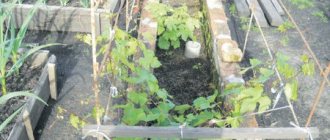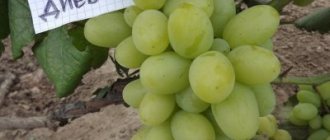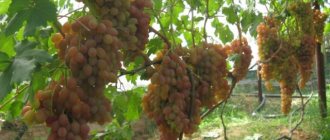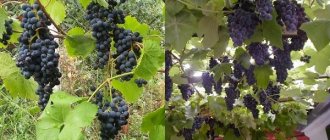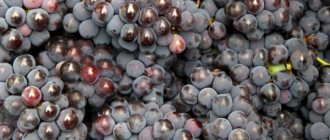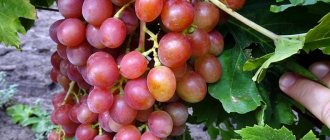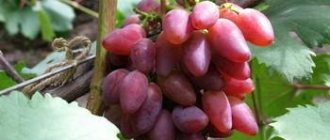Among table grape varieties, the Viking variety stands out for its early ripening of fruits. The berries have a beautiful appearance and can become a real decoration of the garden. Good taste and long-term preservation of berries on the bushes are its undoubted advantages.
- 2 Description of the Viking grape variety
2.1 Video: Viking grape variety
- 5.1 Photo gallery: signs of mildew
History of growing the Viking grape variety
The Viking grape variety was obtained by V.V. Zagorulko (Ukraine). This famous breeder has developed more than 25 hybrid grape varieties. The priority direction of its selection is to obtain early-ripening, large-fruited species that are maximally resistant to frost and susceptibility to disease. The Viking variety, obtained by crossing the ZOS-1 and Kodryanka varieties, has precisely these properties.
The bunch of Viking grapes has a conical shape, average weight - 600 g
How to plant correctly?
The hybrid takes root well in chernozem soil; it is best planted in the southwestern or southern part of the garden. The planting area should not have strong winds or high groundwater. If the ground is waterlogged, then drainage is performed or another place for the grapes is chosen.
Infertile soil is saturated with microelements before planting. Special mixtures (Novofert), wood ash, and humus prepared in the fall are used. It is optimal to plant cuttings from mid to late spring, during the daytime, at temperatures from 14 to 22 °C.
Before planting, you need to check the integrity of the root system of each seedling. It is desirable that it have 3-4 roots 10-15 centimeters long and 2-3 millimeters thick. The plant should be elastic, not brittle. After checking the seedling, cylindrical holes with a depth of 60-80 centimeters are dug.
A mound of fertile soil forms on the surface, and the roots of the seedling straighten out. The plant is placed in the hole at an angle, immediately secured with a support and watered with warm water (2-2.5 buckets per 1 hole). The soil is loosened.
Description of the Viking grape variety
Table variety, intended mainly for fresh consumption. The main features of this variety:
- A vigorous, powerful vine.
- The leaves are alternate, large, five-lobed.
- The flowers are very fragrant, small, green, bisexual.
Grape flowers are collected in a panicle
- The berries are oblong, dark blue, large (22x34 mm). The pulp of the berries is juicy, has a pleasant harmonious taste, the skin is not felt while eating.
The pulp of Viking berries is quite dense
- The berries are collected in conical clusters of medium to large size.
Video: Viking grape variety
Features of planting and growing the Viking grape variety
Grapes grow in one place for a long time, so it is important to think about where to grow the vine. A flat, well-lit place is suitable for planting, since a lack of light reduces the quantity and quality of the harvest. The best time is early spring.
Soil requirements: good water permeability, fertility, light mechanical composition.
You can plant grapes with seedlings and cuttings, observe the following conditions:
Before planting, it is necessary to dig up the soil to a depth of 30–60 cm and apply organic and mineral fertilizers. Fertilizer application rates:
| Fertilizer type | Quantity |
| Organic (compost, humus) | 40–60 kg per 10 m2 |
| Mineral (superphosphate) | 0.6–1 kg per 10 m2 |
The distance between rows should be 1.5–3.5 meters, between seedlings or cuttings - 1–3 meters. You can plant seedlings or cuttings in trenches or planting holes to a depth of 50–70 cm.
At the bottom of the planting hole you need to make a small mound, spread the roots over it and cover it with a layer of soil of at least 10 cm, pour in 15–30 liters of water and cover it with soil again. When planting in spring, you should not completely fill the planting hole, this will allow the roots to warm up better and take root faster.
When planting with cuttings, fill the planting hole completely in May-June
Care after planting consists of loosening the soil and watering in dry times, and mulching. Peat, compost, and black agrofibre can be used as mulch.
Recent Entries
5 working ways to use tar in the garden 7 indoor plants that help you get married even in adulthood Indoor plants that can bloom in trouble
Agrofibre retains moisture and inhibits weed growth
In the second half of summer, the vine will need to be chased; for this, the green tops of all growing shoots are cut off. The breeder advises that for the Viking variety it should be carried out above the 12–15 bud.
Chasing - removal of the upper part of the shoot (30–40 cm) with an incompletely formed leaf surface and the main growth point
In the second or third year, trellises are installed and shoots are tied up.
Grapes on a trellis
In fruit-bearing vineyards, the soil is loosened annually, fertilizers are applied, and watering is carried out. Cleaned by hand.
Bunches of grapes must be cut by hand as they ripen
Forum statistics
207033 Messages in 1634 Topics from 5593 Users. Latest user: Amaya Latest message: “Ripening dates are different...” ( Today at 00:37:47 ) Latest messages on the forum.
Now on the forum
22 Guests, 7 Users
Users in the last 15 minutes: yotmast, Sergey Fer, znakomij, Ilya 77, Andrey Gladilin, Alexander K, Tatyana A. [Blocked] [Section Moderator] [Forum Moderator]
Maximum online today: 77 . All-time maximum online: 2758 (28 July 2021, 17:22:51)
Users who visited the forum in the last 24 hours
Total: 304
(Visible: 303, Hidden: 1) 1963, Sergey Fer, yotmast, znakomij, Ilya 77, Andrey Gladilin, Alexander K, Tatyana A., Belgorodets, Anatoly Sivkov, in Astrakhan, hanter64, Oksana Kopp, Tatyana B, sem_en, Alex65 , Vladimir 153, skier, Igor Viktorovich, slavalimon, Alexander Vl., Primorets, OlgaOs, SANYCH, 31rus, mystic69, DorontsovPeter, Andrey Tsvetkov, Buba, Cherkessk, igor222, Andrey76, Elena Z, vlad51, Kenig, Nikolay Rex, Sergey 1965 , Vladimir Buturlakin, DSW, psv1960, Dmitry 77, Vasily V., Vyacheslav03, Natalia Nikolaevna, Sergey Tashchiyan, Nikolay S., Igor Sergeevich, alexsandr, kvg, Pioneer, Ekaterina Polyanina, nicson7, Elena Aleshchenko, Alexander-ask-34, Verona, Igor F., Taker, Quiet, Henry, Yuri72, L.A.P., Gaivoronsky Yuri, Sergeevich, Sergei Chistokletov, Svetlana Streletskaya, Galinka, Alexey Deminov, Naumov Igor, Vyacheslav136, Vardan, Gloomy, Katrin, AndSanych, vladimirm, Mikhno Alexander, Grandfather31, Filippov Oleg, Vladimir ++, Svetla777, Alexey B, Mikhail Alekseevich, Lidia58, Mikhail77, Alexander Bryansky, Vladimir-Kanevskaya, Dil, Amber7394, Marina Protasova, Titova Love, Linx, Alexander66, Natalya, Natalia M, Mikhail Fesenko, ElenkaF, Amaya, Alexander71, Boris 1952, tsv, Maximilian, 25nata35, nadia, GALINA ANOKHINA, Igor_K, Alexander Kolesnikov, Ivan Levin, Pitko, weather forecaster, eSAa, cecet71, atseton, Alexander Smirnov, Vladimir Kostochkin, Vladimir Berdnikov, Gocha, pioneer-2, mers, LeXa_KoT, Sergey 61, Sergey Yuryev, Erem, alexss, Evgeniy52, Skif, lomakin1969, Vladimir Kovba, dayton, Yuri Semyonov, N.A. Sokolov, Pavlentiy, Sa-shura, Volgogradka, Dmitry Anatolyevich, Grandfather Igor, Andrey Lis, Bublichenko Alexander M, Marina Krymskaya, stenlly2010, irahelm, Vyacheslav Vladimirovich, Vladimir Shilov, Aprel, Dmitry Badaev, gheo55, Yura, y_fed, rambo, Yagodka, Valentina Ivanovna, Kryn, oleg9f, DED2, Korotina Svetlana, Delivered Oleg Ivanovich, Eduard., santra, L2k2m7n, Alexander48, Viknik, Andrey 31, m2d, Marshal, Valery Rastorguev, Serg1707, Soshnin Yura, Amateur gardener, Galina, Vasily1111, gardener, marlin64, Salex, sergei, Sergey Ko, Ramiz, victor_, kosmos, potap05, Yuri 36, VitaliySD, Inna161, Vova Kapran, Vladimir Shcherbinin, Valerie, niy1, cfibr, Andrey68, Elvira2017, kulol3, Slavka, thanatos, Serzh1978, Realist, Artur53, max2008-01, LOZA , AlexanderD, Grandfather Young, Natasha, Zayac, ketch, Rita, alx-74, Iv Iv, Alexander150, Igor K, SNovichek, Vasily Viktorovich, VeraNiK, kdm57, Veniaminovich, Boris Sokolyansky, therapist, Capricorn, 77volt, , vikbublik, neposny , Evgen, Victoria Aleksandrovna, Serezha 64, Wintel, Airbone, teri, Sergey Lomonosov, Khramov, serginio, Leonty Yarygin, Irina O., Ser, Nadezhda Grig, zsb, Lyubov S., netolya, Saisan, Agryzkov Alexey, Vadi, Zinaida , Vadim, Alexander Taganrog, Sukhonon Sergey, Snezhinets, Evgen_26, NAU_63, Masha_Sadovod, Gennady163, Krasnovlad1, Alexander Zinoviev, Vasily 53, Roman Fedorovich, Tis, Alexey Sergeyevich, Arnya, Zhek, Nurtas, Kradievska, 64nikolay64, Nick041, Li, Nick041, Li, Nick041, Li, Nick041, Li ZA, Valentine Medvedeva, Sergey43, Andrey S., Nikolay Lipunov, Mst, Vertuoz2, Vladimir VS, NatalyaMed, freesia, Kinna, Mikhail Michurinsk, alekcsan1, VALERY TAMB, Sasha57, MikhAf, Y_Azer, Andrey Beribesov, hunter1955, nut lover, Keys, Ivan Shmelev , Pestle, anton_slash, Nadymchanka, Sergey 31, Volgar, Pavel 64, Tatyana Volzh, Elektronik_t, Alexander 61, spotlight, Alexander Gai, Cheprak, Pirko Alexander, vladimirvrn, Antrikan, asun16, Alexey Viktorovich, YurSanych, bairina, Lekseich, Tatyana Provorova , Sergey Eliseev, Casperzrq, nidergvel
Susceptibility to diseases
Viking grapes have average resistance to diseases such as mildew and oidium.
Mildew and oidium are fungal diseases; to prevent them, first of all, preventive measures are needed:
- collecting and burning affected leaves;
- autumn digging of soil between rows;
- ensuring good ventilation of plants - planting plants with sufficient intervals from each other, timely pruning.
Fungal plant diseases account for more than 80% of all damage to agricultural crops.
Mildew or downy mildew is one of the most dangerous fungal diseases of grapes. The disease is caused by a fungus that overwinters directly on withered leaves and tolerates frost well. The onset of the disease can be seen by oily spots and white coating on the leaves. At the next stage, yellow spots and leaf necrosis appear. The whitish fuzz spreads to the inflorescences and can lead to large yield losses.
Photo gallery: signs of mildew disease
White spots appear on the surface of the leaf
Spread of white plaque on inflorescences and ovaries
Mildew infestation affects berry quality
If whitish fluff has already appeared on the leaves or the grapes have already been affected by mildew in the previous season, you cannot do without chemicals. Such drugs as Radomil, Delan, Thanos, Profit show high effectiveness. Young plantings in spring need to be sprayed approximately every 10 days, and from mid-June every week. When processing, use the dosage of the drug specified by the manufacturer.
Oidium, or powdery mildew, is the most common disease of grapes. Unlike mildew, fungal spores overwinter under the scales of the eyes and on the shoots themselves; at temperatures above 180, the spores begin to actively germinate and affect all parts of the plant. At the beginning of summer, infected buds and leaves turn yellow, and a gray powdery coating appears. Subsequently, the leaves become covered with brown spots and gradually die off, the disease spreads to the berries, which also become covered with plaque.
Characteristic powdery coating of grapes with oidium disease
Treatment of the vineyard against this disease must begin before the buds open. During this period, spraying with sulfur is necessary (dissolve 25–40 g of sulfur in 10 liters of water). After flowering, you can use drugs such as Rubigan, Topaz, Skor, Bayleton, Karatan, following the recommendations of the manufacturers of these drugs specified in the instructions.
Video: processing grapes from oidium, mildew
Diseases
Viking grapes are extremely susceptible to fungal diseases. Prevention of oidium and mildew begins in early spring. Any antifungal drugs are suitable for this. The second antifungal treatment of the vines is carried out before flowering. The third treatment is carried out when the harvest has already been harvested and the plant is preparing for wintering. For the final treatment, you can use Bordeaux mixture.
Viking is a delicious grape that will decorate the table and fill the body with valuable vitamins. It is enough to provide it with proper care and protection from diseases, and then the harvest will not be long in coming.
